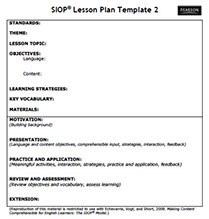Teaching Secondary Reading
A Resource for Improving Academic Literacy with Adolescents ©2015
Differentiation
The best laid plans for instruction can meet bumps in the road when those plans meet actual students. The typical classroom may contain a wide variety of students, by background, knowledge, skills, interests, preferences, etc. Meeting the needs of the full range of learners requires teachers to build a broad repertoire of instructional strategies, including strategies that may work only for some students, while other strategies work for others. There is no "one size fits all" strategy. 
Diane Ravitch (2007) defines differentiation as a form of instruction that seeks to "maximize each student's growth by recognizing that students have different ways of learning, different interests, and different ways of responding to instruction.
"In practice, it involves offering several different learning experiences in response to students' varied needs.
"Educators may vary learning activities and materials by difficulty, so as to challenge students at different readiness levels; by topic, in response to students' interests; and by students' preferred ways of learning or expressing themselves" (p. 75).
Tomlinson (2000) presents a set of beliefs that undergirds this philosophy:
- Students who are the same age differ in their readiness to learn, their interests, their styles of learning, their experiences, and their life circumstances.
- The differences in students are significant enough to make a major impact on what students need to learn, the pace at which they need to learn it, and the support they need from teachers and others to learn it well.
- Students will learn best when supportive adults push them slightly beyond where they can work without assistance.
- Students will learn best when they can make a connection between the curriculum and their interests and life experiences.
- Students will learn best when learning opportunities are natural.
- Students are more effective learners when classrooms and schools create a sense of community in which students feel significant and respected.
- The central job of schools is to maximize the capacity of each student.
Walk through the slideshow introducing differentiated instruction below...
Differentiating Instruction for Students with Special Needs
 The IRIS Center is "a national center dedicated to improving education outcomes for all children, especially those with disabilities birth through age twenty-one, through the use of effective evidence-based practices and interventions." The site contains many searchable, sortable resources, including a glossary of disability-related terms, a catalog of films and books featuring portrayals of people with disabilities, and the IRIS Resource Locator, featuring the IRIS "STAR Legacy Modules," tutorials that lead teachers through issues and solutions related to teaching in classrooms with students with special needs.
The IRIS Center is "a national center dedicated to improving education outcomes for all children, especially those with disabilities birth through age twenty-one, through the use of effective evidence-based practices and interventions." The site contains many searchable, sortable resources, including a glossary of disability-related terms, a catalog of films and books featuring portrayals of people with disabilities, and the IRIS Resource Locator, featuring the IRIS "STAR Legacy Modules," tutorials that lead teachers through issues and solutions related to teaching in classrooms with students with special needs.
Below are several modules aimed specifically at helping teachers improve literacy among their adolescent students. For guidance on how to use the modules, click here.
- CSR: A Reading Comprehension Strategy
- PALS: A Reading Strategy for High School
- Secondary Reading Instruction (Part 1): Teaching Vocabulary and Comprehension in the Content Areas
- Secondary Reading Instruction (Part 2):Deepening Middle School Content-Area Learning with Vocabulary and Comprehension Strategies
- Improving Writing Performance: A Strategy for Writing Persuasive Essays
Differentiating Instruction for English Learners
According to Digital Chalkboard (free account required), all English learners must have full access to high-quality English language arts, mathematics, science, and social studies content, as well as other academic subjects, while simultaneously learning English as an additional language. The California English Language Development (ELD) Standards are intended to support this dual endeavor by providing fewer, clearer, and higher standards that teachers can use to guide their instruction.
- Fewer: Standards that are necessary and essential for language development and academic success;
- Clearer: A coherent body of standards that have clear links to instructional practice and formative assessment practices; and
- Higher: Correspondence with the elevated standards in the CA CCSS for ELA/Literacy and other new content standards.
Digital Chalkboard provides a comprehensive professional development in two modules. Below is a brief introduction to the organization of the California ELD Standards (they are little complicated). Each grade level has a separate set of standards.
Section 1 includes the Goal, Critical Principles, and Overview. For all secondary grades, the Goal and Critical Principles are the same:

The Overview is a color-coded list of the simple standards. The list of standards is broken into 3 main parts:
- Interacting in Meaningful Ways
- Learning About How English Works
- Using Foundational Literacy Skills
There are also four appendices (available on the same page), Appendix A: Foundational Literacy Skills for English Learners, Appendix B: ELD Standards Part II: Learning About How English Works, Appendix C: Theoretical Foundations and Research Base, and Appendix D: Context, Development, and Validation of the Standards.
Section 2 includes an "Elaboration on Critical Principles for Developing Language & Cognition in Academic Contexts" in each of the three parts listed above. The heart of the ELD Standards are the Performance Level Descriptors. English Learners at each grade level are described by their level of performance as Emerging, Expanding, or Bridging.
For example, in Section 2, Part I: Interacting in Meaningful Ways, A. Collaborative, the first standard refers to Exchanging Information and Ideas. English Learners are expected to develop from left to right:

Explore the full set of standards for your grade level(s) and also note how the standards evolve as they address the performance of students at differing grade levels.
Strategies for Differentiating Instruction for English Learners
Sheltered Instruction is an approach to teaching English Learners that integrates language and content instruction. The goals of sheltered instruction are to:
- Provide access to mainstream, grade-level content, and
- Promote the development of English language proficiency.
Sheltered instruction, also referred to as SDAIE, is a teaching style founded on the principle of providing challenging, grade-level instruction in the content (math, science, history, etc.) at the same time as instruction in Academic English language and literacy. The content is explicitly and deliberately not "watered down." While teachers sometimes see SDAIE strategies as "just good instruction" (and they are good instruction), these are strategies specifically aimed at students who are learning the language of instruction at the same time as the content. Below are some sample strategies (Genzuk, 2011):
- Increase wait time, be patient. Give your students time to think and process the information before you provide answers. A student may know the answers but need more processing time in order to say it in English.
- Respond to the student’s message, don’t correct errors. If a student has the correct answer and it is understandable, don’t correct his or her grammar. The exact word and correct grammatical response will develop with time. Instead, repeat his or her answer, putting it into standard English, use positive reinforcement techniques. [As the student develops, incorporate more instruction in English structure and syntax.]
- Simplify teacher language. Speak directly to the student, emphasizing important nouns and verbs, using as few extra words as possible. Repetition and speaking louder doesn’t help; rephrasing, and body language does.
- Don’t force oral production. Instead, give the student an opportunity to demonstrate his or her comprehension and knowledge through body actions, drawing pictures, manipulating objects, or pointing. Speech will emerge.
- Demonstrate, use visuals and manipulatives. Whenever possible, accompany your message with gestures, pictures, and objects that help get the meaning across. Use a variety of different pictures or objects for the same idea. Give an immediate context for new words. Understanding input is the key to language acquisition.
- Make lessons sensory activities. Give students a chance to touch, listen, smell and taste when possible. Talk about the words that describe these senses as students physically experiences lesson. Write new words as well as say them.
- Pair or group students with native speakers. Much of a student’s language acquisition comes from interacting with peers. Give students tasks to complete that require interaction of each member of the group, but arrange it so that the student has linguistically easier tasks. Utilize cooperative learning techniques in a student-centered classroom.
- Adapt the materials to student’s language level, maintain content integrity. Don’t “water down” the content. Rather, make the concepts more accessible and comprehensible by adding pictures, charts, maps, time-lines, and diagrams, in addition to simplifying the language.
- Increase your knowledge. Learn as much as you can about the language and culture of your students. Go to movies, read books, look at pictures of the countries. Keep the similarities and differences in mind and then check your knowledge by asking your students whether they agree with your impressions. Learn as much of the student’s language as you can; even a few words help.
- Build on the student’s prior knowledge. Find out as much as you can about how and ideas and concepts you are teaching and the student’s previous knowledge or previous way of being taught. Encourage the students to point our differences and connect similarities.
- Support the student’s home language and culture; bring it into the classroom. An important goal should be to encourage the students to keep their home languages as they also acquire English. Let students help bring about a multicultural perspective to the subjects you are teaching. Encourage students to bring in pictures, poems, dances, proverbs, or games. Encourage students to bring these items in as part of the subject you are teaching, not just as a separate activity. Do whatever you can to help your fluent English-speaking students see all students as knowledgeable persons from a respected culture.
 The Sheltered Instruction Observation Protocol was developed by Echevarria, Vogt, and Short as a way to improve instruction of English Learners. Click on the image for a SIOP lesson plan template. Click here for more about the SIOP model and short videos introducing each section of the lesson plan template. Online resources are available at many sites, including Mrs. Hilliker's ELL and SIOP Toolbox and at Jill Kerper Mora's MoraModules.
The Sheltered Instruction Observation Protocol was developed by Echevarria, Vogt, and Short as a way to improve instruction of English Learners. Click on the image for a SIOP lesson plan template. Click here for more about the SIOP model and short videos introducing each section of the lesson plan template. Online resources are available at many sites, including Mrs. Hilliker's ELL and SIOP Toolbox and at Jill Kerper Mora's MoraModules.
Click on the slideshow below to walk through each of the points on the SIOP Lesson Plan Template.
The views and opinions expressed on unofficial pages of California State University, Dominguez Hills faculty, staff or students are strictly those of the page authors.
The content of these pages has not been reviewed or approved by California State University, Dominguez Hills.